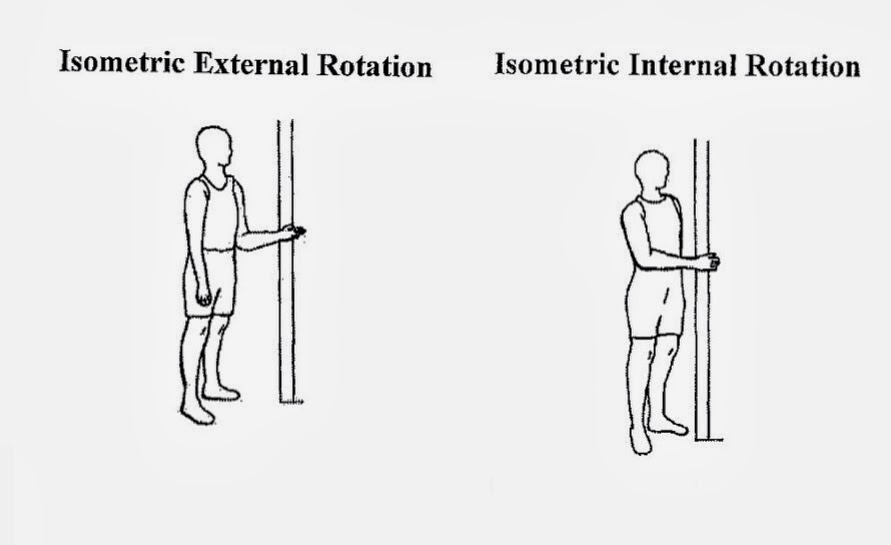

Painful and non-painful isometric exercises caused a moderate but short-lasting increase in shoulder pain in individuals with RCRSP. No changes in PPTs, CPM, or muscle strength after exercises compared with rest were observed.
ROTATOR CUFF ISOMETRIC EXERCISES FULL
Continue to seek full shoulder variety of movement in all planes. Start progressive resistance exercises with weights as tolerated.

Start a more aggressive rotator cuff program as endured. Visual analogue scale scores increased immediately after both painful and non-painful exercises compared with rest ( P = .047, partial ƞ 2 = .07), but were similar to preexercise levels after 45 minutes. Exercises: Wand exercises, ROM shoulder wheels, scapular training (rows, reaches, lower trapezius work, etc), and PNF. No significant differences were observed between painful and nonpainful exercises. Shoulder pain intensity, PPTs, CPM, and external rotation strength were assessed before, immediately after and 45 minutes after conditions. On separate days, 35 individuals performed painful isometric shoulder exercises (external rotation 20% above pain threshold), nonpainful isometric shoulder exercises (external rotation 20% below pain threshold), and a rest condition, in randomised order. Secondary exploratory aims were to describe the effects on pressure pain thresholds (PPTs), conditioned pain modulation (CPM) and muscle strength. The primary aim of this randomized crossover study was to compare the effect of painful versus nonpainful isometric shoulder exercises on pain intensity after exercise in individuals with rotator cuff-related shoulder pain. Rochester, Minn.: Mayo Foundation for Medical Education and Research 2017.Exercise can reduce pain, however the effect of painful versus non-painful exercises is uncertain. Isometric exercise training for blood pressure management: A systematic review and meta-analysis. Isometric handgrip as an adjunct for blood pressure control: A primer for clinicians. The effects of resistance exercise in patients with osteoarthritis: A systematic review and meta-analysis. Principles of rehabilitation physical and occupational therapy. Essentials of Strength Training and Conditioning. By exposing a painful tendon to an isometric contraction the tendon can down. Rotator Cuff (shoulder) or Patella tendinopathies. This means that the muscle group being worked is under tension and producing a contraction but the muscle doesn’t change length. Philadelphia, Pa.: Wolters Kluwer Health Lippincott Williams & Wilkins 2012. Isometric exercise refers to an exercise that uses an static muscle contraction. ACSM's Foundations of Strength Training and Conditioning. Avoid holding your breath and straining during any weight training exercise, as this may cause a dangerous rise in blood pressure. Exercising at a higher level of intensity can cause a dramatic increase in your blood pressure during the activity.Ĭheck with your doctor before beginning isometric exercises if you have high blood pressure or any heart problems. However, if you have high blood pressure, exercise at a lower level of intensity. If you have shoulder pain, when you’re first starting to strengthen your shoulder you want to make sure you perform pain-free exercises. Studies have shown that isometric exercises may also help lower your blood pressure. Rotator Cuff Isometric Exercises (External & Internal Rotation) August 10, 2021. Strength training may help reduce pain and improve physical function. As people with arthritis perform isometric exercises and their strength improves, they may progress to other types of strength training. Isometric training may also be helpful to someone who has arthritis, which could be aggravated by using muscles to move a joint through the full range of motion. For instance, if you injure your rotator cuff, your doctor or physical therapist might initially recommend isometric exercises involving the group of muscles that helps stabilize the shoulder to maintain shoulder strength during recovery. Isometric exercises may be helpful to someone who has an injury, which could make movement painful. They can be useful, however, in enhancing stabilization - maintaining the position of the affected area - since muscles often contract isometrically to aid in stabilization. In addition, since isometric exercises are done in a static position, they won't help improve speed or athletic performance. You'd have to do various isometric exercises through your limb's whole range of motion to improve muscle strength across the range. Because isometric exercises are done in one position without movement, they'll improve strength in only one particular position.


 0 kommentar(er)
0 kommentar(er)
